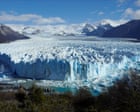
The Earth’s environment, a complex tapestry of ecosystems and climates, is ever-evolving, presenting both challenges and opportunities. From the retreating glaciers of Patagonia to the unexpected avian influx in Italy’s rice paddies and the escalating wildfires in Portugal, the world is witnessing significant environmental changes.
In the majestic expanses of Patagonia, the Perito Moreno Glacier, long considered a beacon of stability in a warming world, is witnessing a concerning transformation. Recent studies indicate that this Argentine glacier is experiencing a substantial retreat, shedding its ice cover at an accelerated pace. Over the past seven years, the glacier has diminished by approximately 1.92 square kilometers, with its thickness decreasing by up to 8 meters annually. Scientists view this development as potentially irreversible, marking a significant shift in the glacier’s long-standing stability, previously defying the global trend of glacial retreat. This change underscores the profound impacts of climate change in even the most resilient natural structures.
Meanwhile, in the picturesque province of Ferrara, situated between Venice and Ravenna in north-eastern Italy, a rather unusual environmental challenge has emerged. Flamingos, relatively new to the region, have taken to the flooded rice paddies — a crucial source for risotto production. These striking birds, with their elegant plumage, have been stirring up the soil in their search for food, much to the frustration of local farmers. As a result, the delicate balance of these agricultural ecosystems is being disrupted, prompting farmers to seek innovative and sustainable ways to coexist with these vibrant newcomers.
As we journey to Portugal, another environmental challenge unfolds with a different but equally urgent narrative. The nation has seen a dramatic rise in wildfires, with the number of incidents increasing by 68% this year compared to the same period last year. Between January 1 and July 11, 3,202 rural fires have been recorded, consuming nearly 9,974 hectares of land. This alarming increase in fires not only poses a direct threat to natural habitats and biodiversity but also impacts local communities and economies. Efforts to mitigate such fires are crucial as they have become more frequent and intense, partly attributed to the burgeoning effects of climate change.
While these distinct environmental challenges in different corners of the world depict diverse narratives, they all illustrate the interconnectedness of natural systems and human activities. They also highlight the importance of adopting sustainable practices and fostering innovations that could mitigate adverse impacts. As global awareness of these issues grows, the call to action becomes more prominent. Stakeholders, including governments, scientists, and local communities, are encouraged to collaborate on solutions that respect and preserve the intricate balance of our planet.
In light of these environmental changes, it is both a challenge and an opportunity to learn, adapt, and develop strategies that will foster resilience in the face of a dynamic, changing world. The harmonious coexistence with nature is not only a possibility but an imperative, as we move forward in understanding and addressing the profound shifts in our environment.
Source: {link}
